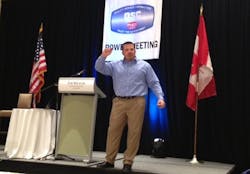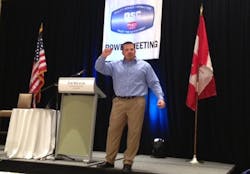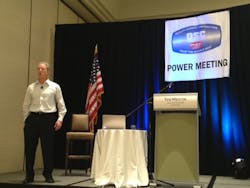Contractors discover their genius at QSC Power Meeting XXXVIII
SAN DIEGO, CALIF. — At the QSC Power Meeting XXXVIII, held here in March, contractors learned how to tap into their genius by using their natural talents; a sure fire way to distinguish, hire and retain top producing employees; and how to measure their company’s performance through their customers’ experiences.
Weeks before the workshops What’s Your Genius? How the Best Think About Success and How to Hire Sales Producers, Not Pretenders attendees took the ADVanced Insights Profile survey by The Results Group LLC. This Innermetrix ADVanced Insights Profile combines the best of three well-known profiles: the Attribute Index measures how you think and make decisions; the Values Index measures your motivational style and drivers; and the DISC Index measures your preferred behavioral style. Together they create the what, why and how (what natural talents you have, why you are motivated to use them, and how you prefer to use them).
Bryan Arzani, vice president and co-founder of Results Group LLC, started the workshop by discussing The Genius Study and the findings of the research, which is based on why some people achieve much greater success with less effort, while others who work just as hard, are just as intelligent, and work in the same environment achieve much less.
“The findings of the research show that being successful requires concrete self-awareness and authenticity — these are the two acquired talents,” said Arzani.
He continued to explain that it’s important to turn right more than turn left, which means it’s most important to know your strengths and stay in a role that feeds those strengths, and if necessary fix the role, not yourself, to be successful. Arzani then walked attendees through their own Innermetrix ADVanced Insights Profile results.
“The DISC Index is one of the most widely used assessment tools in the world, and shows you what type of environment you will be best in,” said Arzani. “DISC is not a predictor of success. It tells me what an individual’s job behaviors are on a day-to-day basis. It also tells me if a person needs to adapt to a job.”
Hiring producers
The afternoon workshop, How to Hire Producers Not Pretenders, was lead by Jennifer Erickson, president and co-founder of Results Group LLC.Contractors need to make sure they hire producers, which can be done by using these interview steps: identify your ideal candidate; attract your ideal candidate; the search; assessment assignment; phone interview; in-person interviews — number of interviews can vary; and any follow-up steps.
“You need a recruitment process in order to measure, manage, monitor and modify,” said Erickson. “This system works because it looks for talent, speeds up the hiring process, allows you to be objective, puts you in control, and since many of today’s candidates have studied how to interview, this process will throw all their prior interviewing experience out the door, so you see the real them.”
It’s also imperative that companies make it easy for candidates to apply. “Stop relying on resumes,” said Erickson. “Resumes are creative writing. Do a phone interview first. The phone interview should mirror their own job buying skills [when interviewing people for a sales oriented position].”
But before a phone interview is scheduled, the candidate should take the Advanced Insights Assessment. Once the assessment is completed, it’s time for the phone interview. And if they pass this interview you can bring them in for a one-on-one interview. During the in-person interview go over their top three strengths; their top weaknesses, and what they need to do to work on them; how they have handled issues with customers; and who is their best and worse manager and why.
Wrapping up the session, Erickson pointed out that a recent study by Michigan State School of Business concluded that tests and assessments are more accurate in predicting job success than interviews, and on average interviews validate at 12% to 20% accuracy. If used in the right application, assessments work.
“The employer is able to see a lot about an individual they wouldn’t normally see when interviewing by utilizing the Advanced Insights assessment,” said Erickson. “This tool shows them how this individual prefers to behave, what motivates them and what their natural thinking style and talents are, so in other words they learn the what, why and how of each person. The assessment allows them to align the opportunities within the company with the right individual for success.”
Kathy Nielsen, team general manager, at Schaal Heating and Cooling, Des Moines, Iowa, is doing just that — working with Results Group LLC to ensure they are hiring the appropriate people for specific positions.
“The Results Group helps to make sure we get the right people on the right seat of the bus,” said Nielsen. “For example, if we want to hire a selling tech, we look for a high drive and we look for one of the top motivators to be economic (money or return on investment). A selling tech that does not have a high drive or high money motivation is probably not going to be successful in that role. He would be better suited to a service tech and turn the leads to someone to sell.”
By using the steps Erickson discussed, the interview process has been improved at Schaal. “A candidate is cut as soon as a ‘knock out’ factor reveals itself either by the profile or by the answers they give,” said Nielsen. “The advantage is saving time and effort. When I first was getting the Internal Control Unit (Schaal’s customer service department) up and going and had to hire five candidates at once, I had 64 applicants. The survey knocked it down to 12. The phone interview knocked it down to six. The face-to-face interview was the final determination and we hired five. This all happened within a couple weeks. Had we had to do it the ‘old fashioned way’ we would have had to have many face-to-face interviews and base it on just experience (you don’t know how reliable a resume is) and if we ‘liked’ them.”
Delivering a positive experience
During the Net Promoter Score (NPS) session, Evan Klein, founder and president of Satrix Solutions and Net Promoter Loyalty partner, discussed how contractors can calculate their NPS, and why this is not only a way to discover how customers view a company’s performance, but also an organizational discipline that enhances companies when implemented at all levels.
Klein started the session by defining NPS, which is based on the fundamental perspective that every company’s customers can be divided into three categories: promoters, passives and detractors. It is also based on The Golden Rule and good profits vs. bad profits.
“By asking one question — How likely is it that you would recommend this company to a friend or colleague? — you can track the progress of these groups [promoters, passives and detractors] and get a clear measure of company performance through your customer’s eyes,” said Klein.
The concept behind this is that good profits create long term revenue. These are advocates, enthusiasts and promoters of a company. “Delighting customers leads to valuable customer behaviors such as repeat purchases and more referrals,” explained Klein. “Examples of good profits are delivering consistently great service, passing along cost reductions, generous return policies and long-warranty periods.”
On the other hand, bad profits happen when a customer feels misled, mistreated, ignored or coerced. The profits from that customer are bad. Examples of bad profits are poor delivery or a poor experience, aggressive sales tactics, complex pricing schemes and extra fees.
The NPS is a discipline used to create a culture in which all employees strive to deliver a positive customer experience. Klein said that this system is so popular because it’s easy to understand, simple to execute (it’s a short survey), easy to communicate, and something a team can rally around.
The history of NPS began with Fred Reichheld, who noted a connection between customer satisfaction and behavior, which then leads to growth. He then embarked on a research endeavor to survey thousands of customers, dozens of companies and numerous industries.
“It was found that it’s not just one interaction, but the entirety of the experience customers have with your company,” said Klein. “Plus, significant value comes from referrals as happy customers serve as advocates for your business through positive word of mouth.”
On a scale of zero to 10, the customer needs to rate a company a nine or 10 to be a promoter; detractors rate a company zero to six; and passives rate a company seven or eight.
“Promoters are loyal customers who will typically make repeat purchases and give the company a larger share of their spending,” said Klein. “They talk up the company to their friends and colleagues, fueling sustainable growth.”
What are the first steps a contractor can take to apply this to their company? Klein recommends that contractors first need to identify a way to survey customers (online survey tools, questionnaire embedded in website, paper, etc.) and encourage response after each project. The next step is to calculate their NPS after receiving a reasonable number of responses (maybe 30 to 50) on a monthly, quarterly or semi-annual basis.
Ending the session, Klein told contractors that the NPS is not just a number, it’s an organizational discipline. “You must also educate employees, align the company culture and hold people accountable,” said Klein. “It’s also important to celebrate success, understand what creates promoters and detractors, and then set priorities. Deliver ‘wow’ service at every touch-point.”
Applying The Golden Rule is also a must when using NPS. “Too often companies pay lip service, but it’s more challenging to ‘act’ that way,” said Klein. “The Golden Rule is a trickle down affect. It is never too late to get people thinking this way. Service excellence remains one of the best ways to differentiate your company from the competition.”
Net Promoter, Net Promoter Score and NPS are registered trademarks of Bain & Company Inc., Satmetrix Systems Inc., and Fred Reichheld.
About the Author
Candace Roulo
Candace Roulo, senior editor of CONTRACTOR and graduate of Michigan State University’s College of Communication Arts & Sciences, has 15 years of industry experience in the media and construction industries. She covers a variety of mechanical contracting topics, from sustainable construction practices and policy issues affecting contractors to continuing education for industry professionals and the best business practices that contractors can implement to run successful businesses.


